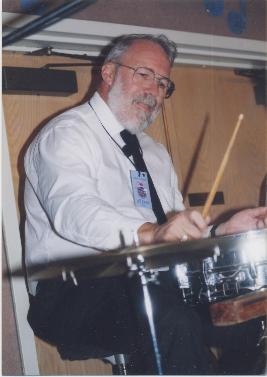CD REVIEW by Bert Thompson
TWO GREAT DIXIELAND JAZZ BANDS (Merry Makers Record Company
MMRC-CD-32). Playing time: 49 mins. 11 secs.
Len Barnard’s Jazz Band:
Moose March; Big Fat Ma and Skinny Pa*; Texas Moaner; Wait till You See My
Baby Do the Charleston; Lord, Let Me in the Lifeboat; Mr. Jelly Lord; Stomp Off,
Let’s Go.
Personnel: Bob Barnard, cornet; Frank Traynor, trombone, vocal*; Earl “Tich” Bray,
clarinet; Greg Clarke, piano; Peter Cleaver, banjo; Bill Fredrickson, tuba; Len
Barnard, drums.
Recorded Melbourne, Australia, October, 1953.
The Gin Bottle Seven:
Down by the Riverside; Electric Chair Blues*; Ostrich Walk; Apex Blues; Oh, Baby;
Bombay Blues; Liza; Everybody Loves My Baby.
Personnel: Carl Halen, cornet; Bob Butters, trombone; Martin Kollstedt, clarinet;
Fred Gary, piano; Jan Carroll, banjo, guitar, vocal*; John Pollock, tuba; Tom Hyer,
drums.
Recorded Dayton, Ohio, March 23, 1955.
These two recording sessions were first issued as 10” LP’s back in the days of vinyl,
and they have been long out of print. Indeed, they were difficult to obtain even
when in print since the Barnard disc was available only in Australia on the Jazzart
label (CMS5), and the Gin Bottle Seven on the band’s own label (no number) sold
only from the bandstand. While the Australian label Swaggie did reissue some of
the Jazzart sessions, it did not this one. So we are indebted to Ted Shafer for having
made both sessions available again and probably to a wider audience than was the
case when they were first issued.
The Barnard Jazzart disc had an additional tune, the title being given as New
Orleans Hop Scop Blues, which is not included on this CD. Apparently there was
some doubt if the tune is, indeed, New Orleans Hop Scop Blues, so it was decided
not to include it here.
There is also some question about the recording dates. Those given above are from
the Bruyninckx discography, while the CD gives the Jazzart as simply 1952 and the
Gin Bottle Seven as 1954. However, I have found that the Bruyninckx discography
is not infallible, so here one must take his pick.
These two bands, from different sides of the world, have several things in common.
The instrumentation is the same, and their heritage similar in that both have
obviously listened to the bands of the U.S. West Coast revival, such as Lu Watters
seven-piece band, Turk Murphy’s group, etc. But it should be noted that there is no
attempt on either band’s part to copy these predecessors—each establishes its own
sound, thus differing from the other as well.
Also at the time members of both bands were youthful, none more so than Bob
Barnard—a mere stripling of seventeen summers and brother of Len Barnard. Carl
Halen was right behind him, being in his mid twenties then, as were all of the other
musicians of both bands. Given the youth of the bandsmen, it should come as no
surprise that the performances, particularly those of Len Barnard’s group, perhaps,
are marked by vigor, exuberance, and any other such traits one could ascribe to
youth, resulting in driving jazz. I would defy anyone with a detectable pulse to try
to stop his foot tapping as he or she listens. And despite their youth, these
musicians were not short on talent or technique. These are not “garage bands.”
Quite striking is the incredible trumpet playing of the youthful Bob Barnard. He
shows a maturity far beyond his years, his ability to improvise being astonishing
and a definite harbinger of the acclaimed musician he was to become and is to this
day. While both bands lean heavily on ensemble work, solos being kept to a
minimum, one can almost sense young Barnard’s impatience to “get back in” with
the ensemble at the end of a solo, and when he does, he and the others tear it up.
Halen, on the other had, is just a bit more reserved, but by no means tame. His lead
is quite authoritative as well, the result being some musically satisfying renditions
of the tunes by the Gin Bottle Seven. The band is not averse to a slight touch of
hokum, either, as the jew’s harp solo on Down by the Riverside attests.
So this CD is well worth having. (I would remind the reader, however, of the caveat
regarding the paper label that the Merry Maker CD’s now sport. Also, there are no
liner notes with this CD.) It is a pity that the additional Barnard title was not
included, despite the uncertainty of the title. As I said above, this was a fine band,
so anything additional would be a plus, and certainly the disc’s playing time of a
little over forty-nine minutes would have accommodated it. But it is good to have
access to these recordings, despite the short playing time, and the pleasure one will
derive from listening to the performances should more than make up for it.
This CD is available from Ted Shafer at his Jelly Roll Jazz Band gigs, by writing
him at Merry Makers Record Company, 926 Beechwood Circle, Suisun City, CA
94585, or by calling him toll-free at 1-866-563-4433 for $16.00, post paid. It should be
obtainable from mail order sources that carry Merry Makers label CD’s.
|
|


